

How gamification can transform your business. In their new book The Gamification Toolkit: Dynamics Mechanics, and Components for the Win, Wharton legal studies and business ethics professor Kevin Werbach and Dan Hunter, dean of Australia’s Swinburne Law School, offer new tools for taking gamification to the next level.

In this interview with Knowledge@Wharton, Werbach discusses how to avoid the pitfalls of gamification, when gamification can be most effectively used to solve business problems and which companies are using gamification successfully. An edited transcript of the conversation follows. A Deep Dive on the Game Elements in Gamification: The Gamification Toolkit is a follow-up to the book For the Win, which I also wrote with Dan Hunter.
For the Win introduced the concept of gamification: how to use game design elements and techniques to motivate people in business. Key Takeaways: One of the key takeaways in this book, and in all of the work that I’ve done on gamification, is that it’s not as easy as it looks. Corporate Gamification Is The Hip Thing Nowadays? Why? Gamification is thriving inside the enterprise. Gloria Lombardi interviews Mario Herger, CEO and founder of Enterprise Gamification Consultancy to learn more about the state of gamification inside large organisations.

By Gloria Lombardi Opinions may vary, but there is no denying that the use of gamification inside the enterprise is becoming an effective way to engage staff with their organisations. "If you want employees to share knowledge and collaborate, you need to have not only a platform but motivated people," says Mario Herger, CEO and founder of Enterprise Gamification Consultancy LLC. Herger, who comes originally from Vienna, has been living in Silicon Valley for over 13 years. It was his passion for innovation that brought him to California where many technology trends are born.
Today, Herger consults, trains, speaks and writes - he has already produced seven books - on everything gamification-related. The power of reputation "Putting the tool out there and hoping that people will come is not helpful," he says. Roadwarrior at SAP. Deconstructing Learning Games: Good vs. Bad. Learning games have it rough.
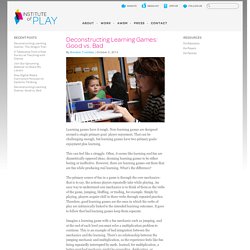
Non-learning games are designed around a single primary goal: player enjoyment. That can be challenging enough, but learning games have two primary goals: enjoyment plus learning. This can feel like a struggle. Often, it seems like learning and fun are diametrically opposed ideas, dooming learning games to be either boring or ineffective. However, there are learning games out there that are fun while producing real learning. The primary source of fun in a game is through the core mechanics- that is to say, the actions players repeatedly take while playing.
Study Finds Gamers Are Better Learners. Gamified Training in the Corporate Workplace. Gamification Myths Debunked: How To Sidestep Failure And Boost Employee Learning. It’s Not All Fun And Games: The Pros and Cons of Gamification at Work. In the never-ending effort to motivate employees, companies are taking cues from video games–adding scoring, virtual badges, and other game-like elements to everyday work processes to make jobs more fun.
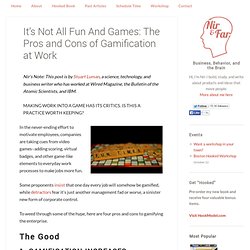
Some proponents insist that one day every job will somehow be gamified, while detractors fear it’s just another management fad or worse, a sinister new form of corporate control. To weed through some of the hype, here are four pros and cons to gamifying the enterprise. The Good. Your Answer to Lackluster Customer and Employee Engagement: Add Fun.
Gamification -- a hot buzzword these days -- is the business equivalent of mixing broccoli into mac and cheese.
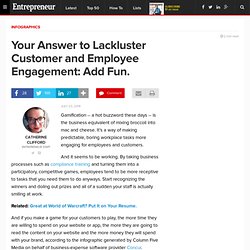
It’s a way of making predictable, boring workplace tasks more engaging for employees and customers. And it seems to be working. By taking business processes such as compliance training and turning them into a participatory, competitive games, employees tend to be more receptive to tasks that you need them to do anyways. Start recognizing the winners and doling out prizes and all of a sudden your staff is actually smiling at work. Related: Great at World of Warcraft? And if you make a game for your customers to play, the more time they are willing to spend on your website or app, the more they are going to read the content on your website and the more money they will spend with your brand, according to the infographic generated by Column Five Media on behalf of business-expense software provider Concur.
Five Steps to Enterprise Gamification. Gamification is a hot new trend in business.

As with any emerging trend, the best practices are still emerging. Some businesses are taking a “chocolate covered broccoli” approach by simply adding points, badges, and leaderboards to their applications and calling them gamified. This article offers another approach. It outlines a road map to meaningful gamification via a five-step process called Player Centered Design. Defining competencies via Gamification. Build out Learning Competencies through a Gamification Strategy – something simple and something that works!

Competency development is one of the most foundational and tricky areas of learning. Building out good competencies- which map to good learning, that map to good assessment- allows for a full feedback model that you can use to track learner development and understand and address knowledge gaps. The challenge with delivering training on a competency model after it is built out is that often times it is presented in a way that is much too formal for the average learner to get much use out of. Many times you have built excellent terminal and enabling objectives, fantastic performance objectives and have spent a good deal of time mapping everything to a learning plan with assessments and gap assessment models built in.
When it is presented to your learners they fail to see the blood, sweat and tears that went into this plan and many times just don’t see the beauty of your hard work. How to Gamify Your Business (Infographic) Gamification is typically thought of as a way to engage consumers, but it's also a way to help employees stay engaged in your company.
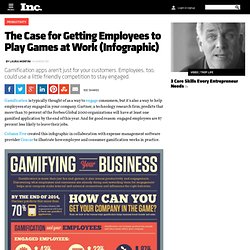
Gartner, a technology research firm, predicts that more than 70 percent of the Forbes Global 2000 organizations will have at least one gamified application by the end of this year. And for good reason: engaged employees are 87 percent less likely to leave their jobs. Column Five created this infographic in collaboration with expense management software provider Concur to illustrate how employee and consumer gamification works in practice. How gamification has become serious business in enterprises. Games are serious business for online retailers such as Step2 Co.
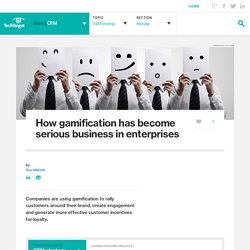
The Streetsboro, Ohio-based online children's toy store recently added a game-like twist to its customer reviews, turning these comments into a BuzzBoard, a social loyalty program. The company crowned the most prolific reviewers as Queen Bees, and they receive $20 gift certificates for their contributions. The goal is to encourage more customer content. Reviewers are promoted through the ranks, with trajectories from New Bee to Honey Bee to Super Bee, and finally to Queen Bee as they provide product reviews, videos and photographs, share that content on Facebook, and earn positive ratings from other BuzzBoard members. The points these reviewers earn also get them $5 to $20 credits toward future purchases. Known as gamification, companies are increasingly seeing the virtues of providing customers with incentives to solidify brand loyalty or encourage new purchases.
Why Companies Need to Use Gaming Science to Rake In Top Talent. Employers need to embrace game science in their search for the business leaders of tomorrow- G2G3Reuters The summer months are traditionally a time when thousands of graduates are competing for a place on a corporate graduate scheme.
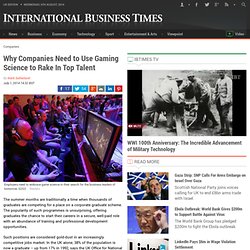
The popularity of such programmes is unsurprising, offering graduates the chance to start their careers in a secure, well-paid role with an abundance of training and professional development opportunities. Such positions are considered gold-dust in an increasingly competitive jobs market. In the UK alone, 38% of the population is now a graduate – up from 17% in 1992, says the UK Office for National Statistics). Graduates who fail to gain a position on a corporate scheme can be left with no choice but to start in a role for which a higher educational background is not usually required.
Is Scientifically Validated – Now What? Since the beginning of the gamification movement, we’ve had our fair share of naysayers. Some have been academics, others simply impassioned folks with strong opinions. At their most charitable, these critics have stated – as fact – that basic gamification mechanics simply won’t (can’t) work. At their worst, they’ve accused us of being manipulative, under-informed distorters of “true” game design – taking umbrage with our movement even when we’ve been working in the constructive public interest.
Discussion and evaluation of our approaches have been further hampered by the insistence – even by some of our most ardent supporters – in making our basic mechanistic elements into the stuff of derision. PBL (Points, Badges, Leaderboards) have been used by well-meaning folks as shorthand for banal, insipid ideas in gamified behavior design. Now the science is starting to catch up with us. You can read the research here and an article by the study’s authors describing their work here. The Gamification of the Literary Mind. In the spring of 2015, Chris Columbus will deliver a film called Pixels, which is basically a bit of sci-fi goofery but which stumbles, too, upon a smart bit of brain science. Aliens have misinterpreted satellite feeds of vintage arcade games and, assuming we mean them harm, have retaliated in kind by launching their own eight-bit warrior versions of PacMan and Centipede.
The movie stars Adam Sandler, which tells us something about how seriously we’re meant to take all this. Gamification, Video Games and Productivity. I have a confession to make: I LOVE video games. Ever since I was a kid. Whether it was Commander Keen on my family’s first 386 computer or Final Fantasy VII on Playstation – I’ve always enjoyed playing video games. But little did I know, that playing video games actually makes you a better and more productive knowledge worker. Here’s how. I always thought that video games were “just for fun”. The theory goes, any activity in the world can be “gamified”, or given game-playing characteristics to create a perception of the activity to the people undertaking it. There are a number of reasons why – the mainstream adoption of video games, the idea of apps on mobile and portable devices, the widespread adoption of social media platforms (which often in turn are gaming platforms), and the old-fashioned reason: people just want to have fun.
Gamification Engages Students with Intrinsic and Extrinsic Motivators. By Michelle Peterson Monday, August 11, 2014 On a planet where people spend 3 billion hours a week playing video and computer games, it's a good chance that using the tools that keep people engaged in games might work in a learning environment, too. Gamifying classes is also a good way to humanize the online, digital environment for students, according to Mark Relf, the state program coordinator for Rasmussen College, speaking to educators and allies at CompTIA's Academy Educator Conference in Phoenix. “Gamification is not anything anyone’s cornered the market on. These are techniques and tricks we can do within our classes to make the experience a little bit better,” Relf said. It’s like playing the license plate game on a long road trip: adding make-believe and goal setting to arduous tasks makes them more engaging. Game On: Businesses Use Techniques from the Gaming World to Increase Engagement.
The business world is taking a cue from the gaming world, increasingly using a system of incentives and old-fashioned competition to spur employee engagement. Gamification, which started out on video game screens with top score designations and leaderboards, is now helping companies meet real-life objectives. “We’re taking what we know from games … and applying that to non-game contexts,” said Mike Campanelli, senior systems engineer at RadiantBlue Technologies, in a presentation from the AFCEA Emerging Professionals in Intelligence Committee to the entire Intelligence Committee. Gamification is used to motivate people to achieve goals. In the business world, that means improving engagement, transparency of work and connecting employees’ actions to business outcomes. The consumer world adopted the concept in the last decade, with applications like Foursquare that digitally reward people checking in to places and through loyalty programs at stores that allow consumers to earn discounts.
How to gamify your crowdfunding campaign like a Boss. 30 Facts About Gamification in eLearning Infographic. Microsoft Word - Document6 - Leonard2012.pdf. Can Consumers Play their way to Better Financial Health? Serious Games: Using Game-based learning for corporate training. We don't stop playing because we grow old; we grow old because we stop playing. Gamification increases engagement and retention levels. 5 Free Gamification Ideas: Motivate Your Employees The Old-fashioned Way. Game on: could gamification help business change behaviour? The Gamification of Education Infographic #gamification #edtech. Playing games for employment: Defining the mission. Young people dig into the problems they face when looking for jobs. Will Wright on Gamifying the World: From SimCity to the Future. Will Wright Shares His Experience on Gamifying Systems and Simulations One of the most phenomenal experiences of GSummit SF 2013 happened with Will Wright’s keynote talk.
As the creator of SimCity and countless other games and simulations, Wright’s talk goes deeply into games’ and their effect on us as humans in society and what that means for gamification in the grand scheme of things. Five Essential Steps for Gamifying Education. How Can We Implement Gamification? Daily Process Thoughts. 4 Reasons Training Should be Gamified — Launchfire. A Simple, Science-Backed Way To Solve The Employee-Engagement Problem. A Few Rules of Management for Playing the Gamification Game.
Why Gamifying Tasks Is Good for Business. How Can We Implement Gamification? Daily Process Thoughts. Octalysis: Complete Gamification Framework. Octalysis: Complete Gamification Framework. How Gamification Will Impact Your Sales Initiatives. Your Employees Are Telling You What Motivates Them. Why Aren’t You Listening? Case study: 3 heavyweights give gamification a go. 'Gamification' Techniques Increase Your Employees' Ability To Learn By 40% Why gamification and big data go hand-in-hand - data-driven marketing, customer insights, gamification, big data, real-time marketing, customer loyalty programs.
Gamified Management Processes Can Boost Employee Performance. The Psychology of Fun: Transform Awareness into Impact. Engaging employees through games. Gamified Training: A Winning Formula for Collections Staff. 8 Great Resources About Game Based Learning - EdTechReview (ETR) Foursquare’s Gamification goes Awry. Gaming the globe: a short history - technology. Gaming at work cracking tough diseases. Welcome to Forbes. How to Gamify Your Goals: A Step By Step Guide.
Enterprise Gamification – Exploiting People by Letting Them Have Fun. A game to be played at work: using gamification to engage your staff. The Gamification Revolution Goes Global. A game to be played at work: using gamification to engage your staff. How to Use Gamification to Motivate Your Agents. Gamification. What Is the Future of Gamification? [Survey] Gamify your business - game-mechanics and game-dynamics. The twenty-first century will be gamified, or it will not. Three Thoughts on #Games & #Gamification. The ten rules of gamification. How to Use Game Mechanics to Reward Your Customers. Gamification Platform. 7 Winning Examples of Game Mechanics in Action. 5 examples of great gamification. Smart Gamification: Seven Core Concepts for Creating Compelling Experiences. How gamification is reshaping businesses. Gamification Facts & Figures. Featured Post. Gamification.
Companies Adopt Gaming Techniques to Motivate Employees. A Few Gamification Examples in Business - Trainingstation. Reinventing Customer, Employee Engagement Through Gamification - Reinventing-Customer-Employee-Engagement-Through-Gamification.pdf. Featured Post. ... 2012: The Year Enterprise Gets in the Game : Gamification Of Work. Gamification: Three Ways To Use Gaming For Recruiting, Training, and Health & Wellness. Gamification. Gamify. Gamification and Serious Games. Business Intelligence for the Games & Entertainment Industry. Gamification Blog. Gamify - Everything's a Game. Gamasutra - The Art & Business of Making Games. Core Concepts of Gamification. Game Mechanics & Design. Gamification: Insights And Emerging Trends. Gamification. Game Elements: What are they and Why are they so Effective?
What can gamification do for a small business?